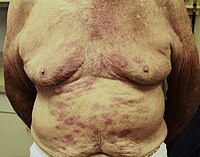
Photo from wikipedia
Background: Dimorphic fungi may cause infections and symptoms similar to tuberculosis (TB), in humans and animals. Such infections, individually or concurrently with TB, have been identified in cattle in Kenya,… Click to show full abstract
Background: Dimorphic fungi may cause infections and symptoms similar to tuberculosis (TB), in humans and animals. Such infections, individually or concurrently with TB, have been identified in cattle in Kenya, raising the possibility of infections in other animals, including humans. The study aimed to identify and quantify dimorphic fungi co-infection in persons with TB. Methods: Smear-positive sputum samples, 400, were obtained from TB clinics between October 2016 and November 2017. The samples were examined microscopically for yeast fungi, cultured for isolation of yeast, conversion to molds, and conversion from molds to yeasts. The isolates were characterized morphologically. Results: Blastopores, with morphological characteristics of Paracoccidiodes and Blastomyces, were observed in 37 smears of the sputum samples. Similar yeast cells were observed in smears of the sputum cultures. The yeast cultures were converted to molds on incubation at room temperature and back to yeasts on incubation at 37°C. Conclusion: Dimorphic fungi, morphologically identified as Paracoccidiodes and Blastomyces, concomitantly infect a proportion of TB patients in the study area. It is recommended that routine diagnosis for TB should consider infection or co-infection by dimorphic fungi for institution of appropriate treatment.
Journal Title: International Journal of Mycobacteriology
Year Published: 2020
Link to full text (if available)
Share on Social Media: Sign Up to like & get
recommendations!